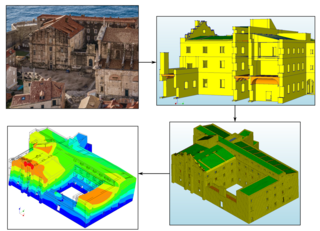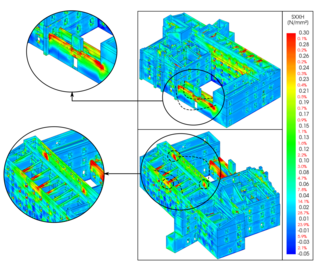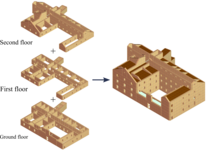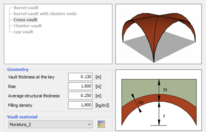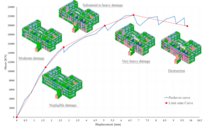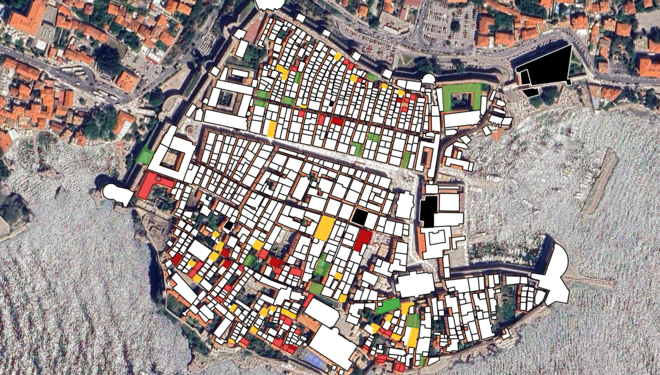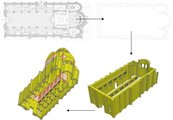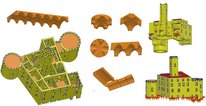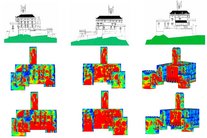Publications
Earthquake Performance of a Cultural Heritage Building: The Jesuit College in Dubrovnik, Croatia
Aanis Uzair, Lars Abrahamczyk, Dagoberto Gómez, Kinda Elias, Ante Vrban, Davorin Penava, Snježana Markušić
Proceedings of the 2nd Croatian Conference on Earthquake Engineering - 2CroCEE
Zagreb, Croatia - March 22 to 24, 2023
DOI: https://doi.org/10.5592/CO/2CroCEE.2023.23
Cultural heritage buildings generally refer to the ancient structures having high cultural and historical significance. These buildings are constructed using obsolete practices and require special considerations with respect to the lateral resistance, especially in moderate and high seismic regions. This study focuses on the earthquake performance assessment of the Episcopal Seminary Building and Classical Gymnasium (Jesuit College) located in the Old City of Dubrovnik, Croatia (UNESCO World Heritage Site). The construction dates back to 1662 and was developed in different stages until 1765. During this period, Jesuit College suffered damages from two major earthquakes i.e., M7.6 Dubrovnik in 1667 and M6.9 Montenegro in 1979. The material composition, structural drawings, and fundamental frequencies of the building were previously obtained in the framework of the research project “Seismic Risk Assessment of Cultural Heritage in Croatia – SeisRICHerCRO”. The material is predominantly composed of irregular stone blocks laid in lime mortar. The structural details such as floor vaults, arches, flexible diaphragms, and spatially irregular openings are numerically modelled using the finite element method. The analytical model is calibrated by performing eigenvalue analysis to compute the material parameters i.e., elastic modulus and density (supported by extensive literature review) that allows the modal frequencies to match with the values obtained from the ambient vibration testing. The seismic performance is then evaluated using the linear analysis procedure in accordance with the current guidelines of the Eurocode 8 and the corresponding Croatian National Annex. For the design earthquake, critical damage zones are identified and recommendations for retrofitting measures are proposed.
Citation: Uzair, A., Abrahamczyk, L., Gómez, D., Elias, K., Vrban, A., Penava, D., Markušić S. (2023): Earthquake Performance of a Cultural Heritage Building: The Jesuit College in Dubrovnik, Croatia. 2nd Croatian Conference on Earthquake Engineering ‒ 2CroCEE (pp. 394-405). Zagreb, Croatia: Faculty of Civil Engineering, University of Zagreb. https://doi.org/10.5592/CO/2CroCEE.2023
Seismic Performance Assessment of the 18th Century Jesuit College in Dubrovnik’s Old City
Aanis Uzair, Lars Abrahamczyk, Ante Vrban, Davorin Penava
Buildings (Seismic Vulnerability Analysis and Mitigation of Building Systems)
DOI: https://doi.org/10.3390/buildings13081904
The seismic performance assessment of heritage architecture presents many challenges due to the restrictions set forth by the conservation principles to protect the associated social and cultural values. These buildings are typically characterized by unreinforced masonry walls connected by tie-rods, vaults, and wooden floors. The era of construction dates to the time when seismic design regulations were largely unknown, making heritage structures potentially vulnerable to earthquake damage. This study presents the seismic performance assessment of the Jesuit College located in the southern part of the Old City of Dubrovnik. A series of field surveys were conducted to qualitatively examine the material composition and obtain geometrical details in part of the Croatian Science Foundation research project IP-2020-02-3531 entitled “Seismic Risk Assessment of Cultural Heritage in Croatia—SeisRICHerCRO”. The structural response is thoroughly investigated by means of a complex finite element model calibrated using the frequencies determined from ambient vibration measurements and material characteristics obtained from the literature review of representative cultural heritage buildings. The seismic performance is evaluated using linear static and response spectrum analysis in accordance with Eurocode 8 guidelines for the demand seismic action level. The numerical analysis indicates several structural components in the building exhibiting high shear stress concentration and exceeding the elastic tensile limit under the demand ground acceleration level. The assessment further reveals substantial out-of-plane bending of vulnerable wall components (identified by local mode shapes) at low peak ground acceleration levels. The stress concentration in numerous structural components leads to the identification of vulnerable zones where retrofitting measures are essentially required.
Citation: Uzair, A., Abrahamczyk, L., Vrban, A., Penava, D. (2023): Seismic Performance Assessment of the 18th Century Jesuit College in Dubrovnik’s Old City. Buildings. 13(8):1904. https://doi.org/10.3390/buildings13081904
Assessment of the Earthquake Performance of a Cultural Heritage Building: Episcopal Seminary Building and Classical Gymnasium in Dubrovnik, Croatia
M.Sc. Dagoberto Gómez Bonilla
This thesis presents a detailed modelling of the Jesuit College using finite element software. From ambient vibration measurements obtained by previous testing campaigns, the finite element model is updated and equivalent material properties for the masonry of walls and vaults are obtained. The earthquake performance of the case study is assessed from the results of a Response Spectrum Analysis, in compliance with the corresponding Eurocode and Croatian National Annex guidelines. The outcomes present the development of shear, tensile and compressive stresses in the linear range, from the application of seismic loads. It is possible to identify critical zones where the highest stresses are located, as well as the potential type of damage and development of cracking after verification of material stress limits. Based on the results, recommendations are provided for retrofitting measures that can improve the earthquake performance of the building, as well as proposals for further development of the work.
Assessment of the Earthquake Performance of a Cultural Heritage Building Applying the Equivalent Frame Method in Dubrovnik, Croatia
M.Sc. Kinda Elias
This thesis presents a detailed modelling of the Jesuit College using macro-modelling. The Equivalent Frame Modelling approach, which requires less computational effort, was used for the assessment of the building. The geometry is modelled using available data in the finite element modelling software. As part of the modelling process, all structural details such as vault systems in the first-floor slab and flexible diaphragms in the upper floors are represented, in addition to openings in the external and internal walls. Based on the modelled geometry and frequency obtained from the in-situ testing, the model updating process is performed in accordance with the results of the eigenvalues analysis to calibrate the Young's modulus E, shear modulus G and density ρ. The model updating is supported by reference material parameters based on observations from visual inspection. Following the calibration of the model, a global and local analysis of the building was performed with the help of the Response Spectrum Analysis, based on the guidelines from Eurocode and the Croatian National Annex. Then the Pushover Analysis was preformed, and the damage grades of the building were obtained based on the EMS98 scale. Following the Out-of-Plane analysis for certain walls was conducted and the critical peak ground acceleration for each case was defined. The main outcome of the study is identification of critical zones at the global and local levels. Based on this information, the earthquake performance of the Episcopal Seminary Building and the Classical Gymnasium is evaluated. Furthermore, conclusions are drawn regarding the potential location of damage in the event that the expected design earthquake occurs. In addition, recommendations are made for improving the seismic performance of the building through retrofitting works, as well as proposals for further development of the work.
Urban Scale Earthquake Risk Assessments of Old City of Dubrovnik, Croatia
M.Sc. Mahdi Doctor Arastooye Marandi
Cultural heritage properties require special sensitivity in treatment, particularly due to their construction as irregular, unreinforced masonry structures characteristic of their historical periods. These structures are highly vulnerable to earthquakes, as evidenced by the region's seismic history. For instance, the 1667 Dubrovnik earthquake, with a magnitude of approximately 7.6, stands as one of the most devastating in Croatian history. The primary focus of this study is to formulate and develop urban-scale earthquake risk assessments for the old city of Dubrovnik, Croatia by evaluating earthquake hazard, building vulnerability, and exposure, with particular emphasis on utilizing the European Macroseismic Scale (EMS-98) and the GNDT II level approach for masonry buildings.
The study employs various scenarios to assess building vulnerability, including best, worst, and intermediate cases to mitigate uncertainties and consider a wide range of possible results. The intermediate case shows closer statistical proximity to real earthquake damage scenarios. The research emphasizes the importance of accurate building information obtained through meticulous inspections to enhance prediction accuracy. The damage maps reveal a seismic risk zone in the middle area of the city due to underlying soil conditions, consistent with observations from the 1979 Montenegro earthquake. This underscores the vulnerability of buildings in this area, as evidenced by the concentration of retrofitting projects there. Conversely, the northern and southern parts, situated on bedrock, exhibit relatively lower vulnerability. The study utilizes QGIS software to illustrate detailed maps for the building block survey on an urban scale.
Earthquake Performance of a Cultural Heritage Building: Cathedral of St. James in Šibenik, Croatia
M.Sc. Muazzam Shah
Preserving the masonry architectural heritage in European countries is a significant concern, particularly in landscapes where such structures contribute to the cultural identity. Alongside historical research, on-site inspections, and laboratory testing, analysing the structural behaviour is crucial for determining effective preservation or strengthening techniques for ancient constructions and monuments. Numerical modelling plays a pivotal role in assessing the overall behaviour of historic buildings, allowing the reproduction of real structural dynamics, simulation of various scenarios, evaluation of safety levels, and comparison of different strengthening methods.
This thesis focuses on the earthquake performance of the Cathedral of St James in Sibenik, Croatia. The research is structured into three key phases: a comprehensive review of existing knowledge, the development and calibration of a 3D numerical model using Diana FEA v10.7 based on the Finite Element Method, and the execution of structural analyses to predict earthquake-induced damages. The structure's behaviour is assessed in the final stages using response spectrum and nonlinear time history analysis. The outcomes of these analyses are studied with a focus on tensile stresses, shear stresses, and displacements at critical nodes. The findings offer insights into the structural behaviour of the Cathedral, identifying vulnerable elements where material stresses either surpass or approach the limits of masonry walls and vaults. Conclusions drawn from the study predict potential damage locations in the event of a design earthquake. Critical areas prone to maximum stress vulnerability include the drum beneath the dome, the junction between the barrel vault and clerestory wall, the front apse, and the wall in the transept area. Additionally, recommendations are provided for retrofitting efforts aimed at enhancing the seismic response of the building.
Earthquake Performance Assessment of Cultural Heritage Building: Case study of Castle Trakošćan, Croatia
M.Sc. Ikramullah Qayyum
The Trakošćan Castle in Croatia stands as a significant monumental landmark with a construction period spanning from the 13th to 18th century, reflecting centuries of history and architectural evolution. Situated in a region prone to seismic activity, the castle faces constant vulnerability to earthquakes, as evidenced by the significant damage that occurred during the Zagreb and Petrinja earthquakes in 2020, emphasizing the need for seismic retrofitting and conservation measures. Ancient masonry buildings, while capable of bearing vertical loads, often lack the structural integrity to withstand the lateral forces generated by earthquakes.
This study aims to evaluate the earthquake performance of Trakošćan Castle using the Finite Element Method in conjunction with Ambient Vibration Testing. In the first step, a comprehensive 3D finite element model is created based on existing architectural drawings in DIANA v10.7. The model is then calibrated by aligning the analytical frequencies with the fundamental vibration frequencies obtained from ambient vibration tests conducted in 2021. Following calibration, the structural response to seismic events is assessed using both linear response spectrum and nonlinear time history analysis, utilizing ground motion records from both the Zagreb and Petrinja earthquakes. The results of these analyses are examined, with particular attention given to displacement at predefined monitor nodes, tensile stresses, and shear stresses. Finally, the analytical damages from the time history analysis are then correlated with the observed in-situ damages to derive conclusions.
The outcome provides understanding regarding the structural performance of the Trakošćan Castle, pinpointing members susceptible to damage, where material stresses are either exceeded or are close to the design capacity. Moreover, in correlation to the observed damages the analytical damage pattern shows consistency of the analysis results, while the additional stresses provide insights into potential outcomes if similar earthquakes are to occur again. Furthermore, suggestions are made for retrofitting measures to enhance the building’s seismic resilience.


